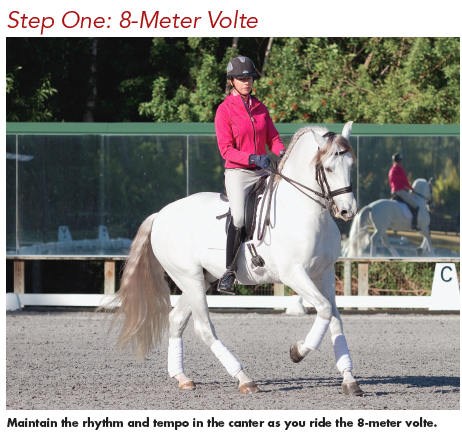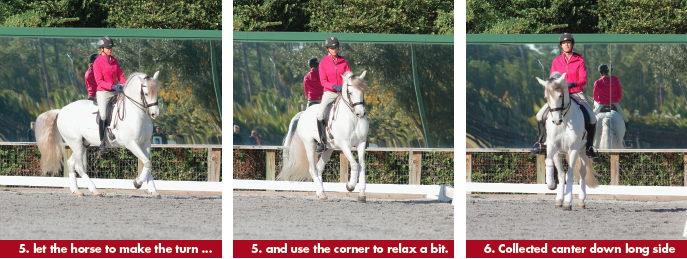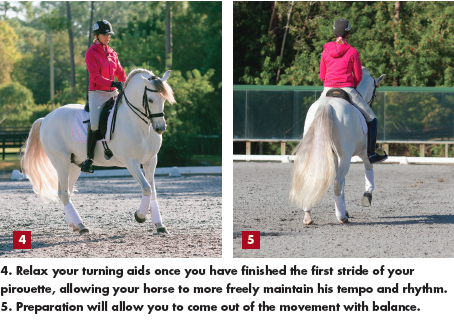The six to eight strides of a beautifully performed canter pirouette can be one of the most elegant moments of an Fédération Equestre Internationale (FEI) test, but they can also be the most difficult. With proper development through the levels and execution of the exercises in this series, this movement does not have to be so intimidating. It is possible to look forward to showing six to eight of the best strides you and your horse have to offer.
Once you are on your way to mastering the pirouette canter (see “Prepare to Pirouette” in the March issue) and can achieve ultra collection in the gait, you are ready to begin the working pirouette (5-meter volte) that is required in Fourth Level, Tests 2 and 3.
PRE stallion owned by Tamara Gerber of Wellington,
Florida.
The desired canter for training the working pirouette is a notch freer and more forward than the ultra collection you have been working on diligently. This is so you can really focus on maintaining both the quality of the gait and connection from back to front while teaching the horse how to turn in balance. Remember this as you follow steps one through four to properly develop the small pirouette.

Step One: 8-Meter Volte
1. Begin in right-lead collected canter down the long side.
2. Ride a little ultra collection on the quarterline in shoulder-fore.
3. When you can ride in and out of ultra collection with relative ease, then return to a straight, moderately collected canter.
4. At E ride an 8-meter volte in the moderately collected canter, concentrating on maintaining a three-beat canter rhythm.
5. Repeat in the left-lead canter.
If your horse struggles with maintaining the clarity in the canter, ride forward and straight to refresh the “da, da, dum” of the rhythm. Collect the canter again and ride the volte again. Try not to slow down or speed up your aids as you ride the volte.
The most common problem is that the horse slows the tempo and loses the clarity of the canter rhythm. Often this is caused by the rider using too restricting a hand to turn or collect, and the restricting hand slows the hind legs down. To help with this, make sure you can soften your hand in the ultra collection before adding the difficulty of turning and ensure that your horse follows your rein aids easily while turning on larger circles and corners.

Step Two: 8-Meter Volte in Haunches-In (Working Pirouette)
The next step in the progression to a true working pirouette is to ride a volte in haunches-in. This exercise is designed to make sure you have control of the outside hind leg when turning. If your horse throws his haunches in and steps too far to the inside with the inside hind leg, stay away from this exercise and focus on riding small voltes in shoulder-fore instead.
1. Begin in right-lead collected canter down the long side.
2. At E, ride into the 8-meter volte you practiced in Step One.
3. When you have the circle established, add haunches-in by using your outside leg a little back. If your horse resists moving his haunches, make sure you get a correct reaction with your outside leg aid.
4. Focus on keeping the jump and clarity of the canter as well as the contact and bend.

Step Three: Controlling the Working Pirouette
If Steps One and Two are in place, it’s time to put together a really good working pirouette. When training this movement, it is best to prepare on a straight line—a diagonal, quarterline or centerline. Let’s begin with the following exercise:
1. On the left rein, pick up the right-lead (counter) canter.
2. Ride down the quarterline, maintaining the counter canter.
3. Develop shoulder-fore in counter canter to ensure straightness.
4. Begin to ultra collect (in shoulder-fore) as you near the end of the quarterline and approach the short wall in front of you.
5. On the approach to the short wall, ride a working half pirouette to the right, back to the wall. As you ask your horse to turn, support his outside hind leg with your outside seat bone and leg a little back so his haunches do not escape to the outside. The corner actually will help you to relax a little on the turn and allow the horse to turn with less effort from you. This allows you to feel how to help him balance, engage and stay connected over his topline.

6. As you are parallel to the track, ride a little forward into a collected canter down the long wall.

7. Ultra collect again as you ride down the long side.
8. As you approach the short wall turn another half pirouette back onto the quarterline.
9. Ride down the quarterline in a collected counter canter.

10. Repeat the same exercise on the right rein in left-lead (counter) canter.
Step Four: Turning a Small Pirouette
When you and your horse have mastered the working pirouettes, you are ready to make them smaller. The radius of a finished pirouette is the same as the length of your horse, so a longer horse will make a larger pirouette than a shorter horse. The finished pirouette should ride something like this:
1. Ride a lively right-lead collected canter and turn down the quarterline in the same canter.
2. With a half halt, ultra collect in shoulder-fore for one or two strides. Support the bend and activity with your inside leg, the flexion with your inside rein, and the collection and outside hind leg with your outside rein, seat and leg.
3. Look in the right direction, toward your pirouette, and begin your turn right. With your inside leg at the girth and your outside leg slightly back, encourage the turn as you sit upright with a bit more weight on your inside seat bone. Each stride should be equal, but you probably won’t ride each stride the same way to achieve this.

4. Relax your turning aids a little after the first stride. This will allow your horse to maintain his tempo and rhythm because you are less restrictive in the rein aids.
5. Begin to ride out of the pirouette with your inside leg and outside rein a stride or two before you actually want to finish so that you can calmly and with balance come out of the movement on the line you desire.

6. Finish on a straight line in ultra collection in shoulder-fore for one or two strides.
7. Ride quietly forward into your lively (and lovely) collected canter.
8. Repeat on the left lead.
In a really good pirouette, your horse’s activity, suppleness, connection and bend stay the same throughout. The best way to help your horse maintain these qualities is to stay supple, connected and feeling throughout. Both you and your horse will be less stressed and more successful if you take the time to train with feel. First, you must clearly understand the theory behind the training of the pirouette and then allow yourself to ride and train with feel.
Potential Problems and Their Fixes
Your horse loses impulsion when turning. Probable causes include the rider taking away too much canter in the ultra collection before the pirouette or trying too hard to keep the horse collected during the turn. The horse may be behind the leg or the rider may be blocking the hind leg with too-strong rein aids. Sharpen the horse’s reaction to a quick leg with a swift kick, a quick spur correction or a tap with the whip. Reinforce your ability to soften after a collecting half halt.
Your horse loses engagement and collection and turns a circle instead of a pirouette. The probable cause is losing control of the outside hind leg, which falls out. Ride your voltes in haunches-in until you know you can keep the outside hind leg under your outside seat bone when you are turning. During the working pirouette keep your seat bones in correct position (it is common to have them slide to the outside) and your outside leg holding the outside hind leg under your seat bone.
Your horse turns too quickly. Probable causes include losing engagement, lateral balance and bend. Practice larger pirouettes and make sure to keep your horse in correct bend with your inside leg to outside rein. An excellent exercise to improve this tendency is to ride quarter pirouettes at each corner of a square with each corner taking three strides.
Your horse comes above the bit and uses his head and neck to lift his front end around. Your horse is probably avoiding really using his hind end and back to carry more in this difficult collection. Practice your ultra collection and small voltes, asking your horse to lower his neck and follow your softening hand (and bit) forward and downward.
Your horse does not turn quickly enough. Probable causes include your horse putting his haunches to the inside before the turn and not having the shoulders mobile enough. Make sure you are riding into the pirouette in shoulder-fore. Practice moving your horse’s shoulders in front of his haunches on circles and straight lines in collected, medium and ultra collection. Make sure your horse’s shoulders will follow his head when turning a circle or corner. Counter-flex for a moment to ensure that your outside rein can displace the shoulders to the inside. Also check that you are looking where you are going and turning yourself in the direction of the pirouette.
Some horses have super talent for the pirouette and can bring them small quite early in their training while most take years of consistent physical and mental training. If you put too much pressure to do a small pirouette too soon, your horse may be unable to balance, become worried about the movement and only learn to compensate by using his body incorrectly.
Even at shows (where the judge usually gives a similar score to pirouettes that are too large and ones correctly sized that lose balance, connection or engagement), I would rather take a 6 for a pirouette that is too big with the other components well done because it has the foundation of a better small pirouette. If you take the time and don’t hurry to bring the pirouette small, you will be rewarded in the end with a horse that makes it look easy. This is the movement you will look forward to riding.

Shannon Dueck represented Canada at the 1999 Pan American Games (individual silver medal), the 2002 World Championships, the 2003 World Cup Final and the Open European Championships aboard her self-trained horse, Korona. She competes her self-trained mare Ayscha at international Grand Prix. In addition to being an FEI-level trainer and competitor, she holds a master’s degree in equine nutrition and physiology, and she has served on the faculties of Lakeland College, Olds College and Johnson & Wales University. She lives and trains year-round in Loxahatchee, Florida (dueckdressage.com).











